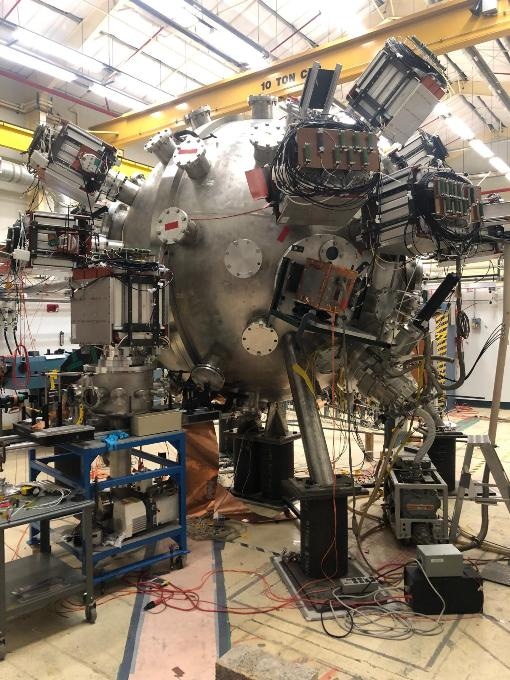Oct 22 2019
Assembly of the Plasma Liner Experiment (PLX) at Los Alamos National Laboratory is ongoing with the setting up of 18 of 36 plasma guns in a single-minded approach to realizing controlled nuclear fusion. The plasma guns are positioned on a spherical chamber, and fire supersonic jets of ionized gas inward to compress and heat a central gas target that helps as fusion fuel.
 Half of the 36 supersonic plasma jets that will make up the Plasma Liner Experiment at Los Alamos National Laboratory have been installed. The remaining jets will be added and fully spherical plasma liner experiments will commence by the end of 2020. (Image credit: Los Alamos National Laboratory)
Half of the 36 supersonic plasma jets that will make up the Plasma Liner Experiment at Los Alamos National Laboratory have been installed. The remaining jets will be added and fully spherical plasma liner experiments will commence by the end of 2020. (Image credit: Los Alamos National Laboratory)
In the period in-between, experiments conducted with the newly fixed plasma guns are delivering fundamental data to develop simulations of colliding plasma jets, which are vital for comprehending and forming other controlled fusion schemes.
A majority of fusion experiments utilize either magnetic confinement, which depends on robust magnetic fields to hold a fusion plasma, or inertial confinement, which uses heat and compression to develop the circumstances for fusion.
The PLX machine integrates features of both magnetic confinement fusion schemes (for example, tokamaks) and inertial confinement machines such as the National Ignition Facility (NIF). The hybrid method, although less technologically developed than pure inertial or magnetic confinement concepts, may deliver a cheaper and less complicated fusion reactor development path.
Similar to tokamaks, the fuel plasma is magnetized to help alleviate losses of particles and thermal energy. Similar to inertial confinement machines, a heavy imploding shell (the plasma liner) quickly compresses and heats the fuel to attain fusion conditions. Rather than NIF's range of high-power lasers powering a solid capsule, the PLX depends on supersonic plasma jets fired from plasma guns.
The PLX has an extra benefit: Since the fusion fuel and liner are firstly injected as a gas, and the plasma guns are positioned comparatively far from the imploding fuel, the machine can be fired quickly without damage to the machine parts or the need for replacement of expensive machined targets.
We will conduct experiments this year to study the formation of a hemispherical liner with 18 guns installed. We hope to complete the installation of the remaining 18 guns in early 2020 and to be conducting fully spherical experiments by the end of 2020. This will allow us to measure the scaling of the liner ram pressure on stagnation as well as the liner uniformity, which are important metrics of the liner performance.
Dr Samuel Langendorf, Scientist, Experimental Physics Group, Los Alamos National Laboratory
Dr Langendorf is guiding the assembly of the PLX.
In its moderately completed state, the PLX guns are proving to be beneficial in studies that Dr Tom Byvank is performing on colliding plasmas.
Different models show discrepancies in the simulations of plasma collisions involving multiple ion species. Our experimental observations of these plasmas help to validate simulations that are important for understanding high-energy-density, supersonic plasmas encountered in astrophysics, aerodynamics and various plasma fusion machines, including the PLX magneto-inertial fusion approach and possibly also inertial confinement designs like the National Ignition Facility.
Dr Tom Byvank, Postdoc, Experimental Physics Group, Los Alamos National Laboratory